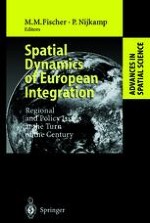1999 | OriginalPaper | Chapter
Costs of European Monetary Union: Evidence of Monetary and Fiscal Policy Effectiveness
Authors : Helene Schuberth, Gert D. Wehinger
Published in: Spatial Dynamics of European Integration
Publisher: Springer Berlin Heidelberg
Included in: Professional Book Archive
Activate our intelligent search to find suitable subject content or patents.
Select sections of text to find matching patents with Artificial Intelligence. powered by
Select sections of text to find additional relevant content using AI-assisted search. powered by
In general, there are two different ways of looking at the costs of a monetary union. Firstly, given the low inter-regional labour mobility in the European Union, whether the benefits of a common currency outweigh costs depends strongly on the degree of asymmetry of real shocks (Mundell 1961). If shocks are affecting countries that fail to meet the flexibility requirements, it would be better for those countries to have the possibility of resorting to the exchange rate instrument to adjust. A common currency may be preferable, however, if the countries are mainly affected by asymmetric money and financial market shocks. In Stage III of the European monetary union, speculative attacks, time-varying risk premia and currency substitution which could cause macroeconomic imbalances will disappear. Many empirical studies deal with the issue of whether the EU-15 are an optimum currency area. Some of these also include considerations about the likelihood of the emergence of new asymmetries in the future monetary union or the decreasing importance of asymmetries compared to the EMS.1
